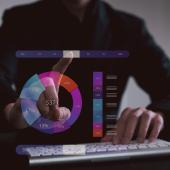The pandemic has transformed lawyer communications with clients, colleagues, staff, opposing counsel, and judges as court hearings, depositions, settlement conferences, mediations, arbitrations, and continuing legal education programs are now conducted virtually. According to Judge Roy Ferguson in a CNN interview, judges in Texas alone have held over one million virtual court hearings to date.
Recently one of these Texas court hearings went viral as an attorney appeared as a sad-eyed, sweet-faced kitten in Texas’ 394th Judicial District Court. The attorney had borrowed his secretary’s computer for the virtual hearing before Judge Ferguson and was unaware a filter had been turned on — and was unable to turn it off. Judge Ferguson tweeted a video of the hearing and it took off worldwide. Within one month, the tweet generated over 14,000 retweets and close to 45,000 likes, and the YouTube video has had millions of views.
Judge: I believe you have a filter turned on in the video settings.
Attorney: Can you hear me judge?
Judge: I can hear you. I think it’s a filter.
Attorney: It is. I don’t know how to remove it. I’ve got my assistant here. She’s trying to, but I’m prepared to go forward with it. I’m here live. I am not a cat.
Judge: I can see that.
“If a child used your computer,” Ferguson warned in his tweet, “Before you join a virtual hearing check the Zoom Video Options to be sure filters are off.”
Being certain to have filters off is not the only useful lesson for lawyers when using Zoom. During the pandemic, I have used Zoom and other video conferencing platforms to teach negotiation courses and present webinars to students and professional groups across the world. Based on these experiences, here are five lessons for the Zoom-based lawyer. (These lessons are adapted from my January post at AACSB Insights.)
1. Select video features intentionally
The good news is that video conferencing platforms like Zoom include features that meet a variety of your conferencing needs. You can chat, conduct a poll, share screens, record, use breakout rooms (especially useful for mediations), annotate materials, and add captions. The bad news is that using too many of these features at one time can complicate and dilute communications. When preparing to use Zoom, take to heart Henry David Thoreau’s plea in Walden to “Simplify, simplify.”
For example, I do not encourage the use of Zoom’s chat function because it leads to multitasking. I also do not use the polling feature extensively because it distracts from the main discussion. However, I do use the features in ways that serve my intentions. Instead of setting up my iPad or other device as a whiteboard, for instance, I find it simpler to use the platform’s annotation feature.
2. Solve the “eye contact” dilemma
In their June 2020 article in the Harvard Business Review, Michael Parke of Wharton and Elad Sherf of the University of North Carolina, Chapel Hill, highlight skills you can use to bring out the best in others. These include asking questions, inviting ideas, following up, and creating a sense of psychological safety.
These skills are easier to apply during in-person meetings, where you can maintain eye contact and scan the facial expressions of others to gauge whether they understand what you are attempting to communicate.
In Zoom interactions, such skills are far more difficult to practice. The “Brady Bunch”-type boxes of participants might not fit on one screen. Noticing when someone wants to make a comment or respond to a question can be difficult.
When I first started teaching via Zoom, I tried to scan faces as I would in an in-person setting, but this distracted me from maintaining eye contact with the camera. I finally stuck a Post-it note near my camera with “Look here” written on it as a reminder. When leading a discussion, I take advantage of the “Raise Hand” icon, which allows me to call on individuals in the order that they volunteer. This prevents a meeting from being dominated by aggressive individuals, which often happens during in-person sessions, and encourages participation by quieter individuals who often have a lot to offer.
3. Improve the 70-percent expectation
Video conferencing platforms present a number of technology challenges, from video freezing to participants forgetting to unmute. Because of such interruptions, there is a consensus that you might be able to cover only around 70 percent of what you would normally cover during an in-person meeting.
To increase this percentage, I try to make my own presentations more efficient. Students now complete a larger percentage of their work outside of class. For example, I refer them to a suite of free negotiation tools that they can use on their own.
And I have condensed coverage of certain topics in class. Instead of a long discussion of a case on negotiation ethics that includes team assignments, I ask the entire class to discuss a shorter scenario where they must evaluate a lawyer’s advice in light of several ethical tests. Then I have them watch The Burger Murders, a five-minute video of the shorter case that Christine Ladwig and I developed for TED in July 2020.
4. Address Zoom fatigue
Lawyers engaged in a long Zoom meeting, which is sometimes followed immediately by other Zoom meetings, are subject to Zoom fatigue. This fatigue is exacerbated when you meet with participants from different time zones. One of my courses that begins at 8 am in Michigan starts at 5 am for students in California and at 9 pm for students in China. Another course that ends at 5:30 pm in Michigan finishes at 4 am the next morning in India.
To address Zoom fatigue, I recommend engaging participants by making your meetings as interactive as possible. Use videos where appropriate, and schedule team-based breakout sessions. I also stand as I teach, which students say increases their energy levels.
When I mentioned this approach to a colleague, he gave me a puzzled look before asking, “If you stand, wouldn’t the camera be aimed at your belt buckle?” For this reason, I also recommend an adjustable desk, like my own, so the camera rises with it when I adjust its height to stand.
5. Embrace flexibility — and humility
Using Zoom from my home study has raised questions that I never faced before. How would I handle a hardware failure or a power outage? Would the video platform crash? What lighting adjustments should I make to minimize an unwanted halo effect on my balding head? How should I minimize outside noise like my neighbor’s lawnmower? How would I respond if Zoom-bombers hacked my session?
My students also encountered unique challenges, some of which might affect your Zoom meetings with clients, colleagues, and staff. One student was forced to drop my course after contracting COVID-19. Another missed class because of contact tracing. One student had Wi-Fi problems when he had to move into isolation, and another lost his broadband connection when he and his 10 roommates streamed at the same time. A new mother had to turn off her camera periodically when pumping breast milk for her son while others coped with distractions from family members or pets.
That’s why it is important to embrace flexibility. When one student lost Wi-Fi twice during a key negotiation, she called in on her phone. I also established a chain of communication to reach everyone if the internet connection failed, and I kept my laptop turned on and ready to go in case my desktop computer gave out.
As it turned out, I lost connection only once, and the lapse lasted only for a few seconds, a scenario that prompted a response from two students who forgot they were being recorded. “Did we lose him?” asked Student A. To which Student B responded, “Yeah, awesome.”
This exchange offers a final lesson: Maintain a touch of humility and a sense of humor as you navigate this technology. After posting the Cat Lawyer video, Judge Ferguson tweeted, “So pleased to have started a tweet that started the whole world laughing. The world needs more of it." But more importantly, he reminded us all that “[t]hese fun moments are a by-product of the legal profession's dedication to ensuring that the justice system continues to function in these tough times. Everyone involved handled it with dignity, and the filtered lawyer showed incredible grace. True professionalism all around!”




